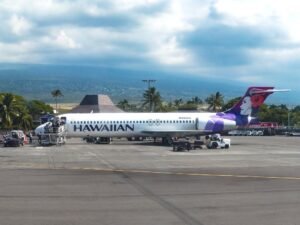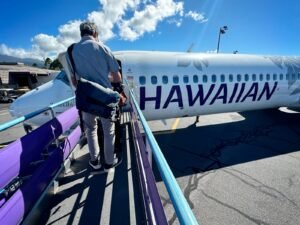Kona airport runway closure, located on the Big Island of Hawaii, serves as a crucial gateway for tourists and residents alike. Recently, the airport has faced a significant operational challenge due to the closure of its primary runway. This article explores the reasons behind the closure, its impacts on various stakeholders, the challenges faced during this period, and the prospects for the future.
Reasons for the Kona airport runway closure
The kona airport runway closure was necessitated by essential maintenance and upgrade work. The runway, which had been in operation for several decades, required resurfacing and structural reinforcement to ensure the safety of aircraft operations. Over the years, the constant use and exposure to the elements had led to wear and tear, making it imperative to undertake these repairs.
Additionally, the upgrade project aimed to enhance the runway capacity to accommodate larger and more modern aircraft. With the increasing number of flights and the growing size of airplanes, the existing infrastructure needed to be updated to meet contemporary aviation standards. This included reinforcing the pavement, improving drainage systems, and installing advanced lighting and navigation aids.
Impacts on Air Travel
The kona airport runway closuret has had a profound impact on air travel. Airlines operating to and from KOA have had to adjust their schedules, reroute flights, and, in some cases, cancel services altogether. This disruption has affected both domestic and international flights, leading to inconveniences for passengers and logistical challenges for airlines.

Passengers have faced delays, longer travel times, and in some instances, the need to rebook their flights. The reduced capacity at kona airport runway closure has also meant fewer available flights, making it harder for travelers to secure bookings during peak times. This has been particularly challenging for tourists, who form a significant portion of the airport’s traffic, as Hawaii remains a popular vacation destination.
Economic Implications
The runway closure has also had substantial economic implications. The tourism industry, which is a vital component of Hawaii’s economy, has felt the impact of reduced flight operations. Local businesses, including hotels, restaurants, and tour operators, have experienced a decline in visitor numbers, leading to decreased revenue. The ripple effect has extended to various sectors, including retail and transportation, which rely on the influx of tourists.
Moreover, the airport itself has faced financial challenges. Reduced flight operations have led to a decrease in landing fees and other revenue streams. This, coupled with the cost of the maintenance and upgrade project, has strained the airport’s budget. Efforts have been made to mitigate these financial impacts through government support and collaboration with airlines and other stakeholders.
Challenges Faced Kona Airport Runway Closure
The kona airport runway closure has presented several logistical and operational challenges. One of the primary challenges has been coordinating the maintenance work while minimizing disruption to flight operations. Given the importance of Kona Airport as a transportation hub, it was crucial to ensure that the closure was managed efficiently to avoid prolonged disruptions.

Another challenge has been communication with passengers and stakeholders. Keeping travelers informed about changes in flight schedules, delays, and alternative arrangements has required effective communication strategies. Airlines and the airport authorities have had to work closely to provide timely updates and assist passengers with rebooking and other arrangements.
Additionally, the closure has necessitated increased coordination with neighboring airports. Some flights have been rerouted to other airports in Hawaii, such as Honolulu International Airport and Hilo International Airport. This has required collaboration between airport authorities and airlines to manage the increased traffic at these alternative airports and ensure smooth operations.
Environmental Considerations
While the runway closure has presented several challenges, it has also provided an opportunity to address environmental considerations. The maintenance and upgrade project included measures to enhance the sustainability of the airport’s operations. This included the implementation of energy-efficient lighting systems, improved drainage to prevent runoff and erosion, and the use of environmentally friendly materials in the resurfacing process.
Moreover, the project has provided an opportunity to evaluate and enhance the airport’s overall environmental impact. Efforts have been made to reduce the carbon footprint of airport operations through initiatives such as the use of renewable energy sources and the promotion of sustainable practices among airport staff and stakeholders.
Future Prospects
Looking ahead, the completion of the runway maintenance and upgrade project is expected to bring several benefits. The enhanced runway will be able to accommodate larger and more modern aircraft, improving the airport’s capacity and efficiency. This will enable Kona Airport to handle increased traffic and support the growth of Hawaii’s tourism industry.
The upgraded infrastructure will also enhance the safety and reliability of flight operations, reducing the risk of disruptions and delays. Passengers can expect improved travel experiences with smoother operations and potentially shorter travel times. Airlines will benefit from the ability to operate larger aircraft and offer more flights, increasing their capacity to serve the growing demand for air travel to and from Hawaii.
In conclusion, the closure of the primary runway at Kona International Airport has presented significant challenges and impacts. However, it has also provided an opportunity to undertake essential maintenance and upgrades that will enhance the airport’s capacity, safety, and sustainability. While the disruption has been felt by passengers, airlines, and the local economy, the long-term benefits of the project are expected to outweigh the short-term challenges. As the airport prepares to reopen its primary runway, the future looks promising for Kona Airport and the broader Hawaii tourism industry.



